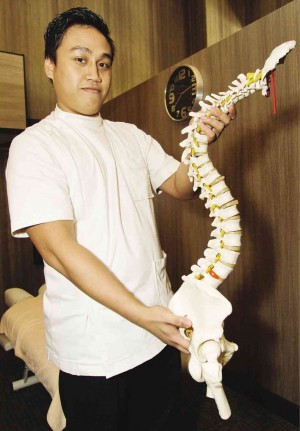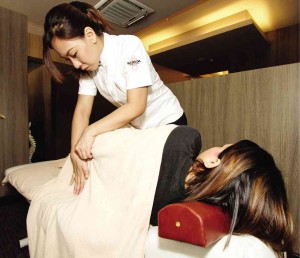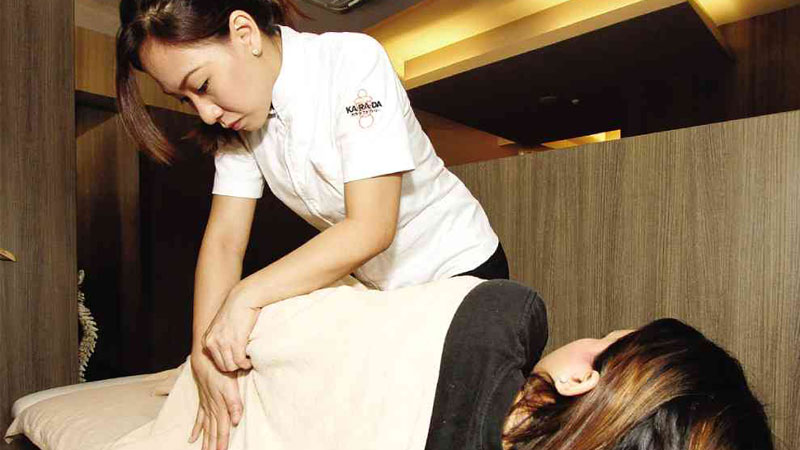
Have you ever felt weak and lethargic, like an impending disease is about to take over your body, but not even your doctors can figure out its origin? Your malaise is not uncommon—and it’s probably not just psychosomatic.
Karada, a Japanese therapeutic center, adopts a clinical approach to many of the body’s stress-related ailments such as shoulder and back pain, muscle stiffness, and locked joints.
Karada, meaning “body,” believes that 70 percent of body pain is caused by stress.
By combining the principles of chiropractic, seitai (body maintenance) and Judo seifuku (judo martial arts), Karada founder Yuki Koyasu developed a patented treatment called Atlas and Pelvic (AP) Balance.
AP Balance realigns the pelvic position, such that it produces a perceivable decrease of body pains almost instantly. It relieves body pain—even chronic pain—and prevents it from recurring. It relieves the body of stress and corrects hormonal imbalance.
Crucial role
The treatment is similar to chiropractic in that they both offer alignment of the spine. Chiropractic treatment adjusts the segments of the spinal column; Karada realigns the atlas or C1, one of two upper cervical vertebrae, and the pelvis. Both play a crucial role in the body’s overall health and well-being.
A simple impairment in the atlas, for example, can, over time, affect the nervous system, circulation and the entire musculoskeletal system. Just like its namesake, the Greek mythological character Atlas, who was condemned by Zeus to support the weight of the earth and heaven on his shoulders, the body’s atlas supports the weight and structure of the head.
“Karada is based on a natural healing power by combining bone realignment with therapeutic massage and stretching,” said Hiroaki Naruse, Karada therapist and trainer, and regional manager of FJG, the Japan-based company that operates Karada. FJG is a health and wellness company that manages and operates close to 200 Karada clinics in Japan.
X-rays and MRIs will not show this misalignment. That’s why when the body feels pain, some doctors attribute it to an unknown source or pronounce the disease as merely psychosomatic. (A specific CT scan is, however, reported to show the imbalance.)
Correcting the atlas vertebrae can improve posture, and can prevent a series of postural defects such as hollow back, functional scoliosis, functional short leg, stiffness, swelling, pain and more. The thumb-based kneading and pulling employed to restore AP balance uses the body’s weight to give pressure, not force.
What the therapist’s hands can’t do, the drop bed can. The center of the mechanical bed drops when pressure is applied. With the client lying face down, the therapist applies pressure on the pelvis, and the center of the bed drops a few centimeters. It’s a method that helps restore AP balance.

“The massage is therapeutic, but we are not a spa. You don’t come here for relaxation. You come here for healing, for finding relief, so you can feel better,” said Rejana M. Stelton, Karada GM. Karada has branches in the new Glorietta (tel. 5538731), Greenbelt Radisson (8437425) and Serendra (8236716).
Painful but relaxing
A session, especially for the first-timer, can be somewhat painful. This experience is what the Japanese fondly calls itakimochii, meaning painful but relaxing. There is usually an instant relief from pain—not always complete, but one that is certainly discernible.
Naruse said it takes between five to 10 sessions to nurse a misalignment back to balance. Functional short leg, for example, sometimes caused by the habit of standing on one leg, can be aligned with one session, but the effects won’t last a week. Standing on one leg is a bad postural habit developed over several years. A session will not be enough to correct it permanently.
Treatment begins with a consultation and assessment, where the therapist will check your mobility limitations and other concerns. This will be followed by a muscle treatment and alignment. A rationale on the root of your conditions will be given at the end of the session.
Body treatment is dry, so there’s no need to worry over possible adverse reactions to exotic oils and creams.

Karada is also safe for children as young as 12 years old, as long as the child has no serious medical injury. The AP Balance may be customized to age and condition.
Assistant to the vice president Sidney Scott V. Stelton said Karada also strengthens the bones, making them more resistant to sprains and other minor injuries. He said Karada can rebalance hormones, and improve blood circulation, flexibility, posture and digestion.
Karada also offers foot treatment for detoxification. Foot spas in the country are mainly for aesthetic purposes, removing dead skin cells from the feet. Karada’s foot treatment is for healing.
For example, manas, or the swelling of the feet, is said to be due to the accumulation of waste products. The foot treatment flushes out the toxins by stimulating the reflex zones of the muscles and internal organs of the body through the feet. This is a technique adapted from a practice in Taiwan.
Karada therapists in Manila have been extensively trained by Naruse. In June this year, it will send its first batch of therapists to Japan for advanced training. The company is also seeking the approval of a Department of Health certification for its therapists.









































